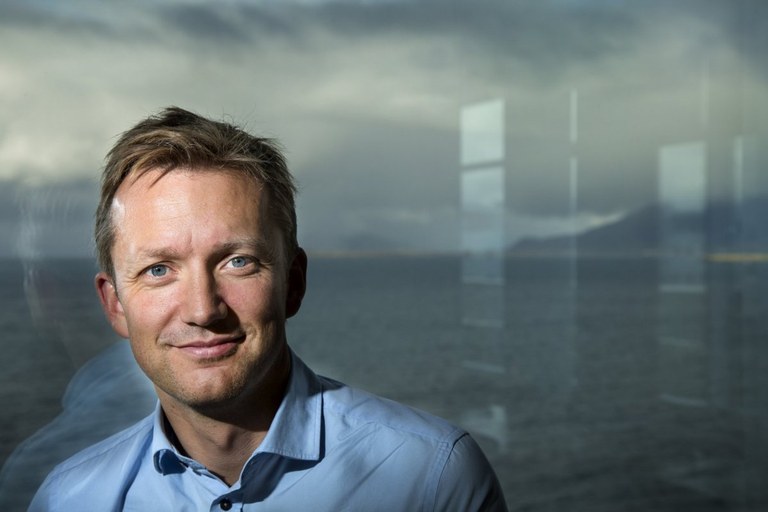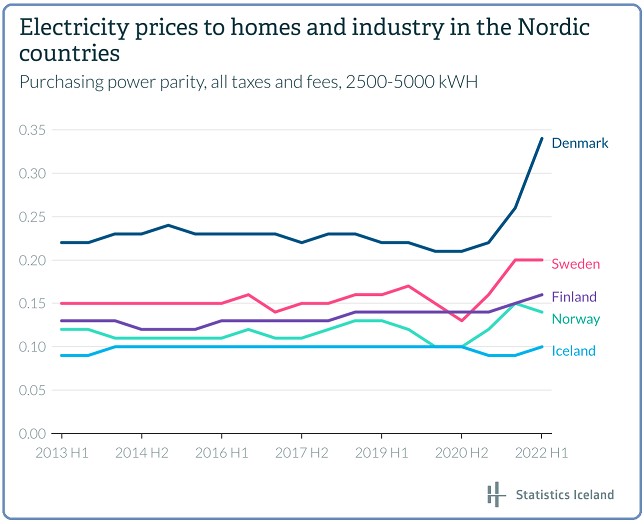How Iceland's industry benefits from being outside of the common energy market
Surging energy prices have been one of the many consequences of the war in Ukraine. This has mainly been felt in Europe since sanctions against Russia have led to considerable cuts in gas imports from there which in turn has pushed prices up.
Iceland is one of the few countries that has not faced these difficulties. Household energy prices have remained pretty much stable for eight years, while it has gone up considerably in other Nordic countries – in Denmark in particular.
One of the reasons is that Iceland has enough renewable energy sources to be self-sufficient, mainly thanks to hydro but also geothermal energy. However, according to some of the leaders of the energy-intensive industries, that is not the only reason. The fact that Iceland is not connected to the common European market helps too.
Aluminium plants in Europe closing
Pétur Blöndal, CEO of The Association of Icelandic Aluminium Producers, points out that it is not only Iceland’s sustainable energy sources that help the production in Iceland, and uses Norway as an example.

Pétur Blöndal, CEO at The Association of Icelandic Aluminium Producers. Photo: Samál
“There are parts of Norway that are not connected to the common European energy market. In these parts, the energy price has been more stable. This applies to the northern parts of Norway for example. But in the areas that are connected to the market, many aluminium producers have had problems.”
Blöndal says that aluminium production has fallen by 40-50 percent in the European Union over the past few years. The reason for that is that most of the aluminium plants have not had long-term energy contracts and have been forced to buy energy in the spot market. In some cases, the energy price was higher than the value of the produced aluminium.
Also, in most cases, the price Icelandic aluminium plants pay for energy is closely linked to the price of aluminium.
“The price of aluminium has been high this year, and producers in Iceland have therefore never paid more for power than they do now, according to a recent press release from Landsvirkjun, the main power company. It also said that the price paid by energy-intensive industries in Iceland is for the most part similar to that of neighbouring countries,” says Blöndal.
He points out that even if the energy crisis had hit Iceland, it would not have changed much in the short term for aluminium producers, because of their long-term contracts with the energy company Landsvirkjun.
“In general, the aluminium producers who have long-term contracts are doing fine. And it is clearly a strength for Iceland not to be connected to the common European energy market.”
Increased interest in data centres
Data centres are another big energy consumer in Iceland. The country has increasingly been marketing itself as an ideal place for them, not only because of the clean energy but also because of access to natural cooling. Sigríður Mogensen, director of creative industries at the Federation of Icelandic Industries, says that when the energy market weakens in Europe it is an advantage for Iceland.

Sigríður Mogensen, director of creative industries at the Federation of Icelandic Industries. Photo: SI.
“This is because Iceland is not connected to the European energy market. So it has turned out well for us that we decided not to have an electric cable from here to Europe as was discussed several years ago. But the data centres see increased interest from European firms in their services .
“Every company, no matter what business they are in, but mainly technology companies, must use data centres, directly or indirectly. So there is increased interest from companies in coming to Iceland with their data.”
Mogensen says that this is clearly the time to market Icelandic data centres in Europe.
“What also helps is that we will soon open a new communications cable from here to Ireland. It has been a bit of a hindrance in the last few years that we have only had two cables connecting us to Europe. Now the third one comes at the same time that the energy market changes, which is very positive for us because the giant tech companies have been worried that connections are not solid enough here.”
Mogensen says that when it comes to energy, the market price is not everything. Predictability is also very important.
“Energy prices have been fluctuating a lot but here they are much more predictable.”
Massive growth if a tech giant comes
Mogensen expects that the data centre industry will grow by 15-20 percent over the next two years.
“However, if a tech giant came to Iceland – someone like Amazon, Google or Facebook that have already built huge data centres in the Nordic countries – that growth would be double or more. And I think that is more likely today than just a few years ago.

The price of electricity in Iceland has hardly changed in the past eight years.
“The advantage of having a stable energy price is more obvious now during the energy crisis. And natural cooling in times of climate change plus the new fibre-optic cable are also big factors here.”
But political will is needed too, according to Mogensen.
“When one of the tech giants built a data centre in Finland, the prime minister welcomed it especially. The same happened when Microsoft built a data centre in Sweden – the minister of education considered it a good contribution to the country’s education system. The discussion hasn’t reached that phase in Iceland yet but this matters if the tech companies are really looking at Iceland as an option.”
This might come as a surprise, but Mogensen says that there is not too much green energy to offer in Iceland if you look into the future.
“We have had to pass on projects throughout the country because of energy shortages, especially since we’re in the process of reducing the use of fossil fuel. We are of course well off in terms of the green energy we have now, but we need more energy to develop our industries further. So there are still some obstacles to our development, not only for new businesses but also for the current ones to grow.”
- Geothermal energy
-
Krafla Power Station, located in the Krafla caldera, northern Iceland, is the largest geothermal power station. It is able to produce 500 GWh of electricity annually, with an installed capacity of 60 megawatts.
Photo: Villy Fink Isaksen, Wikipedia
 Follow us on Facebook
Follow us on Facebook
